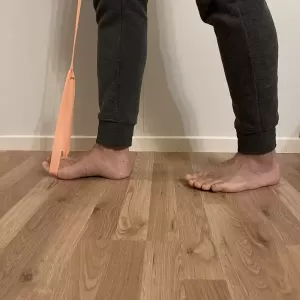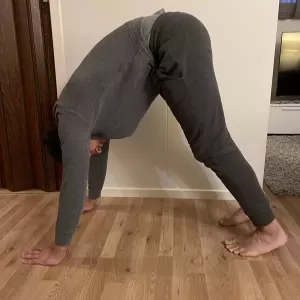Flexor Hallucis Longus Stretch – 3 Best Exercises for Flexibility and PNF Stretching Technique
The flexor hallucis longus (FHL) is a muscle in your leg that helps you move your big toe and point your toes downward. It is especially important for dancers because it helps them keep their feet and ankles in the right position while they dance.
This muscle is also known as the “dancer’s muscle”.
Stretching the flexor hallucis longus muscle can help improve flexibility in the foot and lower leg, reduce the risk of muscle strains and injuries, and improve overall leg and foot function.
Let me show you the best way to stretch flexor hallucis longus.
Related: extensor hallucis longus stretch, stretches for flexor digitorum longus, flexor hallucis brevis stretching exercises, best stretching equipment for home, stretching exercises books.
3 Best Stretches For Flexor Hallucis Longus
1. Standing Flexor Hallucis Longus Stretch with Strap

To perform standing flexor hallucis longus stretch with a strap, stand with one leg slightly in front of the other, bend the front knee, and keep the back leg straight.
Loop a strap around the ball of the front foot and pull gently, feeling the stretch in the back of the lower leg. Hold for 30 seconds
2.Seated Flexor Hallucis Longus Stretch

- Sit in a chair with your feet flat on the ground and your knees bent.
- Lift one leg off the ground and extend it in front of you, keeping the heel on the ground and the toes pointed upwards.
- Reach down towards the toes of the extended leg, and hold onto the ball of the foot with your fingers.
- Gently pull the ball of the foot towards you, feeling the stretch in the back of the lower leg.
- Hold the stretch for 30 seconds
You can use a strip for this exercise too.
3.Downward Facing Dog

Start by standing on your hands and knees with your wrists under your shoulders and your knees under your hips. Lift your hips up and back, forming an inverted V shape with your body.
Keep your arms straight and your hands pressing into the ground, and try to straighten your legs as much as you comfortably can. Push down with your heels to increase the flexor hallucis longus stretch.
How to Find Flexor Digitorum Longus
To locate the flexor hallucis longus muscle, you can sit in a chair with your leg extended in front of you.
Then flex your big toe towards you by using your hand to gently pull on the base of the toe. You should feel a muscle contracting in the back of your lower leg as you flex your big toe.
Alternatively, you can palpate the muscle by placing your fingers on the back of your lower leg, just below the ankle joint, and gently pressing your fingers into the muscle as you flex your big toe.
PNF Stretching Technique for Flexor Digitorum Longus
One of the most popular and effective pnf stretching techniques is the contract-relax technique (CR).
To use the CR PNF technique to stretch the flexor hallucis longus muscle, stand with one leg slightly in front of the other and bend the front knee slightly.
Reach down towards the ball of the front foot, and hold onto it with your fingers.
Contract the flexor hallucis longus muscle by trying to flex your big toe towards you, and hold this contraction for 5-10 seconds.
Then, relax the muscle and gently pull the ball of the foot towards you, feeling the stretch in the back of the lower leg.
Hold the stretch for 30 seconds, then release and repeat the whole process five times.
